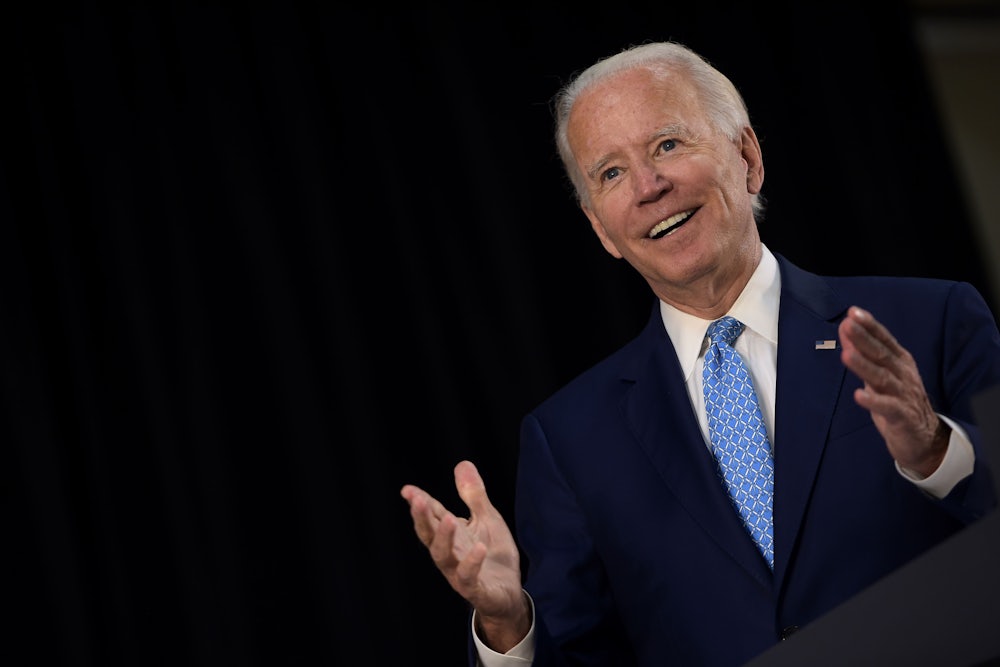Thursday morning, the World Meteorological Organization released a report projecting that there is a one in five chance of global temperatures rising by 1.5 degrees Celsius (2.7 degrees Fahrenheit) in the next five years, a line beyond which millions of livelihoods will become unviable and homes uninhabitable. In the midst of a summer that has already seen Siberia on fire, the prediction felt more than plausible.
The day before, a group of Joe Biden and Bernie Sanders advisers focused on projecting unity in the Democratic Party released 110 pages’ worth of policy recommendations, starting with climate policy. The persistent sit-ins, climate strikes, and insurgent candidate success stories of the past four years seem to have accomplished this much: The policy recommendations contained in this document, like just about every other climate plan to emerge from mainstream nodes of the Democratic Party in the last year, are orders of magnitude more sweeping than anyone, even Sanders, would have thought possible in 2016. Thanks doubtless to the influence of the Sunrise Movement’s Varshini Prakash, Representative Alexandria Ocasio-Cortez, and other left-leaning members of the unity advisers’ climate segment, the document’s climate goals are ambitious: zeroing out building and power sector emissions by 2030 and 2035, respectively; an embrace of environmental justice principles and targeted investments in this country’s most vulnerable communities; installing 500 million solar panels in five years; the creation of a Cabinet position for emissions reductions. Encouragingly, climate also makes an appearance in the recommendations of the economy and immigration recommendations.
Still, the recommendations for phasing out fossil fuels remain weak. The plan doesn’t fully grapple with the crisis now gripping oil and gas companies and the financial sector that supports them. Few international commitments are suggested, leaving the United States to eat up most of the world’s remaining carbon budget.
The plans are better than they were. The plans are not enough. What are the plans for?
Though it’s ostensibly my job to analyze these kinds of climate plans on their own terms, the whole exercise is starting to feel pretty pointless. Documents like the task force recommendations—like presidential campaign platforms or the House Committee on the Climate Crisis report—really only indicate where we’re starting from. So far, all the plans on offer will likely produce warming greater than two degrees Celsius. And that’s a relatively rosy scenario.
The Biden campaign has, at this point, committed only to reviewing the task force recommendations, not to embracing them as part of its platform. Even if Biden does pick up every bullet point, there’s still an open question as to whether he’ll hire senior staff willing to make them a reality and not hire senior staff who’ll block them. And in the extraordinarily optimistic scenario in which the Biden administration is elected and then full-throatedly takes on the climate challenge along the lines the unity task force outlines, there’s only so much that can be done through executive orders and agency maneuvering. Republican control of the Senate, should that still exist, will place a hard ceiling on whether anything called climate legislation makes it to the president’s desk; conservative Democrats will pose a challenge, too. Should it clear all those hurdles, a judicial system packed with Trump appointees can ensnare it in years of legal challenges. And then there are the barriers posed by any number of obscure trade rules.
That strain of sober realpolitik has led even progressive Democrats to moderate their plans so as to conform with some aesthetic commitment to what constitutes reasonable policy. But neither the GOP’s response nor the current moment in world history makes a good case for such preemptive walk-backs. Given that the GOP has likened modest, gradual carbon-offsetting strings on aviation sector bailouts to a Green New Deal, there’s no reason not to talk an actual Green New Deal, which is broadly popular. Nor is this a moment for nihilism: Each 0.1 degree of warming averted translates to tens of thousands of lives saved. Hopefully the pandemic hasn’t so numbed lawmakers to death that those numbers seem trivial.
This is my plea for more honesty in describing new climate policy packages, at least among those of us who have to write about this stuff. Pandemic coverage has pointed to one possible approach. Reporters and analysts are now judging the success of public health measures by hard metrics: The numbers of infections and related deaths are now daily being used as a basis for comparison across cities and states and from country to country. Why not make these sorts of policy assessments a new normal? While projected deaths are admittedly trickier to calculate than recorded deaths, let’s judge climate policies by how many people they’ll kill, anywhere, based on our best scientific understanding of the problem. Let’s not judge them based on the progress they show compared to more obviously inadequate plans, or—for the love of God—by how much they’ll cost. Even in cold and conservative economic terms, the costs of 2.5 or three degrees of warming will outstrip the cost of preventing it by tens of trillions of dollars. Every person who dies of a climate-fueled disaster is a sign of failure of policymakers’ ability to mitigate rising temperatures and adapt to the hotter world that past failures have made inevitable.
There’s been a lot of progress in terms of how ambitious mainstream politicians are willing to be in their climate proposals, virtually all of that owed to pressure from below. By almost any metric, those politicians are still failing.
